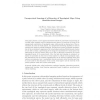Free Online Productivity Tools
i2Speak
i2Symbol
i2OCR
iTex2Img
iWeb2Print
iWeb2Shot
i2Type
iPdf2Split
iPdf2Merge
i2Bopomofo
i2Arabic
i2Style
i2Image
i2PDF
iLatex2Rtf
Sci2ools
IJPRAI
2008
2008
Unsupervised Learning of a Hierarchy of Topological Maps Using Omnidirectional Images
unsupervised construction of topological maps, which provide an abstraction of the environment in terms of visual aspects. An unsupervised clustering algorithm is used to represent the images in multiple subspaces, forming thus a sensory grounded representation of the environment's appearance. By introducing transitional fields between clusters we are able to obtain a partitioning of the image set into distinctive visual aspects. By ing the low-level sensory data we are able to efficiently reconstruct the overall topological layout of the covered path. After the high level topology is estimated, we repeat the procedure on the level of visual aspects to obtain local topological maps. We demonstrate how the resulting representation can be used for modeling indoor and outdoor environments, how it successfully detects previously visited locations and how it can be used for the estimation of the current visual aspect and the retrieval of the relative position within the current visual ...
| Added | 12 Dec 2010 |
| Updated | 12 Dec 2010 |
| Type | Journal |
| Year | 2008 |
| Where | IJPRAI |
| Authors | Ales Stimec, Matjaz Jogan, Ales Leonardis |
Comments (0)

